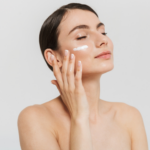I have pretty fair skin, so when I’m in the sun for too long, I’m going to burn unless I wear sunscreen or protective layers. I was recently searching for reasons behind this, and it led me to a question that kept popping up.
What does skin make when exposed to the sun? When the skin is exposed to the sun, it causes the skin to produce more melanin and to darken. As these cells make their way towards the surface of your skin, they’ll be sloughed off, and the tan fades away.
Read on to learn more about how skin reacts when exposed to the sun, also what is melanin, and how to best protect your skin from the sun.
What Does Skin Make When Exposed to Sun?
The sun is slowly killing us, and so are those UV beds if you use them. What can you do about it?
Sunlight that we’re exposed to has UVA (ultraviolet A) and UVB (ultraviolet B) rays. Tanning beds also have UV rays. It is these UVA and UVB rays that are the main causes of damage to the skin. UVB rays have a bit more energy than UVA rays. They can directly damage the DNA of our skin and are the primary rays that cause sunburns.
Ultraviolet light damages all human skin: dark, fair, and all the colors in-between. The reason we even have skin color is an evolutionary response to sunlight damaging human skin.
Ultraviolet light works the same as any other light. It’s either absorbed or reflected — darker colors absorb more than lighter ones. Our skin absorbs and reflects UV light also.
UV light is part of the light spectrum, and though it’s just outside the visible spectrum for humans, it is either being absorbed it reflected by the skin.
When UV light hits the skin, it can be reflected by our outermost layer of skin, the stratum corneum. Light that isn’t reflected hits the inner layer of skin, the epidermis, where it encounters melanin packaged within melanosomes.
When skin is exposed to the ultraviolet rays in sunlight, it darkens or tans. All skin, regardless of color, tans. More melanin scatters more of the damaging UV rays. Melanin in the skin is produced by melanocytes located in the epidermis. Melanin comes in the form of two pigments, the brown eumelanin, and a yellow and red pheomelanin.
Harmful Effects Of Sun Exposure

Dark-skinned humans produce melanin all the time, while lighter-skinned people produce it as needed. Melanin is evolution’s way of scattering the rays of UV light before they can harm your DNA since we no longer have dark body hair to protect us. If our skin didn’t do this, the UV radiation would get through, corrupt our DNA, and cause cancer before we could reach breeding age.
There were probably human ancestors that didn’t tan – and thus, they weren’t able to pass on their genes as efficiently. Sunburns are radiation burns from overexposure to ultraviolet radiation. It turns red because your body is trying to heal the damage and sending blood to the area. The burn isn’t going to protect you from anything; neither will a tan, really. See our post on how to treat sunburns naturally if you are in need of sunburn relief.
Over-exposure to the sun can also result in “photoallergic contact dermatitis.” This type of dermatitis or eczema is caused by chemicals in sunscreen or lotion being exposed to the sun. See our post on this skin allergy caused by the sun and how to treat it.
In the end, all sun exposure results in UV light impacting your skin. It is never-ending. If it’s cloudy, there’s UV. When it’s snowy, the UV can reflect off the snow and cause even more problems. When you’re in a pool or ocean? Yep. UV.
Light-skinned people are most susceptible to skin cancers because they have to make up for not having the melanin in the first place. Darker-skinned people scatter more of the UV rays naturally, and therefore, have significantly lower incidences of skin cancer, according to the Center for Disease Control.
Obviously, you can use sunscreen, which contains organic and inorganic chemicals to block the UV rays that cause cancers. Some of the molecules absorb the rays and release the energy as heat.
A new study from the American Chemical Society found an overabundance of sunscreen in the oceans frequented by beachgoers. The titanium dioxide and zinc oxide nanoparticles in the creams and lotions were reacting with UV rays and creating hydrogen peroxide toxins that kill algae and phytoplankton – the lifebloods of ocean ecosystems. It’s a lose-lose. Though it’s better to wear sunscreen to protect yourself.
More on the Effects of Too Much Sun Exposure
Isn’t it amazing how something 93 million miles away can be so important to us? It’s no wonder that many cultures have idolized the sun as a god. But just like a mythical god, sun exposure brings both beauty and danger. You may see a tan now, but you could have a burn or premature wrinkling and skin cancer later.
The sun helps your skin make vitamin D to keep your bones healthy, keeps your mood elevated, keeps your sleep schedule regular, and even grows the food and nutrients you need to survive. But too much sun can lead to sunburns and other damage you can’t see.
In addition to visible light, the sun makes UV or ultraviolet light. UVB rays will often cause a tan or sunburn, while UVA rays go deeper and can damage your skin’s natural growth, repair systems, and overall appearance.
Skin Conditions Caused by Sun Damage
As you age, it’s naturally harder for the skin to repair itself, which is why you get wrinkles and lines. If you get too much sun, you can speed up this process so your skin ages earlier. The outer layer of the skin gets the greatest sun exposure, but the deeper layer is composed of proteins that will strengthen the skin. These proteins get damaged by the persistent sun exposure, and instead of giving a nice strong, clear skin, they’ll break up and give you wrinkles.
Eventually, all that sun exposure can lead to skin cancer, the most common type of cancer in the U.S. Examine the skin and make sure that you’re aware of what type of lesions are present or not present.
Freckling may be very prominent in some individuals. We’re particularly concerned about pigmented lesions, brown or black lesions, or those with irregular size or shape.
Some more info on what the skin makes when exposed to the sun and other tips for proper care in the sun, see the below video:
How to Protect Your Skin from the Sun
The best way to protect your skin from being exposed to the sun is to wear protective clothing and to cover up. But, using sunscreen is a great way to enjoy the sun and still protect your skin. A sunscreen with an SPF or sun protection factor of 30 means it would take you 30 times as long to burn.
Apply sunscreen 15 to 30 minutes before sun exposure, and apply generously and often. Generally, you should reapply every 2 hours. Water and sweat will make sunscreen less effective, and the effects depend on the strength of the sun and your skin tone, so you may want to re-apply even more often.
Sunscreen can expire, too, so check the expiration date! Some studies that were done in Boston have shown that just exposing the hands to about 20 minutes of sunlight is sufficient to produce enough vitamin D. You can also get vitamin D from food and supplements.
Request a blood test from your doctor to assess your Vitamin D levels before supplementing beyond the maximum recommended daily limit of 5000 IU. To naturally get D3, eat salmon, sardines, egg yolks, and dark leafy greens. If you take a multivitamin, you’ll get the recommended daily vitamin D. If you don’t take a multi, then you should take a vitamin D supplement.
Also, be sure to avoid tanning beds. These are very harmful to your skin and give you more of the damage with less of the benefits of sun exposure. Tanning is not a good thing, so if you are tanning, that is one of the ways that your body responds to damage from the sun.
The sun is great, but it’s undeniably powerful. Even though it’s so far away, its effects are all around us, both good and bad. The best way to avoid sun damage is to limit your time in direct sunlight.
If your shadow is very short, then you should seek shade because the sun is pretty much overhead, and it’s going through the smallest amount of the atmosphere. But later in the day, as your shadow gets longer, you would need less protection. Cover up, embrace the shade, and wear sunscreen.
Conclusion – What Does Skin Make When Exposed to Sun?
So to revisit our initial question, what does skin make when exposed to the sun? When the skin is exposed to the sun, it makes melanin located in the epidermis and darkens. Melanin is a black or dark brown pigment that is in the skin and hair of humans and animals.
As the sun-damaged skin cells make their way towards the surface of your skin, they’ll fall off, and this will make the tan fade back to your normal skin color.

![Neutral Skin Tone Defined [and Best Colors for Neutral Skin] neutral skin tone](https://skincaregeeks.com/wp-content/uploads/2021/05/neutral-skin-tone-150x150.png)







![Read more about the article Say Goodbye To Wrinkles On The Face [Easy Tips to Prevent Them]](https://skincaregeeks.com/wp-content/uploads/2023/04/wrinkles-on-face-1-2-300x200.png)